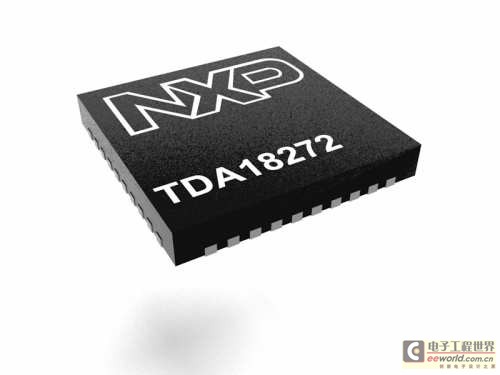NXP ’s new TDA18272 sets the benchmark for silicon tuners
As the TV industry began to fully adopt silicon tuners, NXP Semiconductors (NXP Semiconductors) recently announced the launch of a high-performance silicon tuner for global wireless and cable TV reception-TDA18272. TDA18272, which is compatible with the DVB-T2 standard, supports all analog and digital TV standards worldwide, allowing TV manufacturers to prepare for the next generation of TVs. To date, NXP has sold more than 400 million NXP silicon tuners, which has promoted the popularization of system-optimized silicon tuners. TDA18272 also represents the fourth-generation silicon tuner designed by NXP.

Since silicon tuners are about to replace various traditional CAN tuners based on MoPLL, TDA18272 meets the increasing global demand for highly integrated low-power ultra-thin TV architectures. The small size of the TDA18272 uses a 40-pin, 6x6 mm package, which contributes to the design of ultra-thin flat-screen TV panels. TDA18272 is highly integrated, with RF tracking filter, oscillator, IF selection module and broadband gain control module, without external parts such as SAW filter and balance converter. NXP uses TDA18272 to introduce a unique master / slave architecture designed to optimize the multi-tuner application architecture. TDA18272's production process follows NXP's defect-free plan, so manufacturers can simplify product assembly and supply chain management.
Mr. Robert Murray, general manager and senior director of NXP ’s TV front-end product line, said: “Production-tested silicon tuners such as TDA18272 will quickly replace CAN tuners, just as transistors replaced tubes in the 1960s. TV broadcast tuner development Rapidly, silicon tuners are gradually replacing older radio-frequency analog circuits. NXP ’s silicon tuners can speed up the design introduction process, save production costs and improve performance. They can also save space for multi-tuner systems, thereby reducing energy requirements. "
Mr. Veit Armbruster, Vice President of Development at NuTune, said: "The size and price of traditional set-top boxes and TV tuners are mature, and it is difficult to make further technological progress. To overcome this obstacle, we have been looking for a system with low cost , A highly integrated solution. The silicon tuner that integrates the tuner function and the channel filter is such a component. NXP ’s silicon tuner technology allows us to design products that meet today ’s market needs. At the same time, they The high level of integration is also suitable for multi-tuner applications. "
With the rapid development of cable, satellite, terrestrial broadcasting and Internet content transmission technologies, televisions and set-top boxes have entered a new digital era. Tuners with highly integrated functions and small size have a huge demand. TDA18272 provides TDA8296 IF demodulator as an auxiliary chip for global analog TV demodulation. The IF demodulator integrates a programmable group delay function and a video gain equalizer to optimize system design. In order to shorten the time to market, NXP also provides a full set of auxiliary design kits (circuit boards, documents and software packages) for testing and evaluation.
With more than 20 years of experience accumulated in the field of TV reception technology, NXP has always stood at the forefront of design technology to help TV manufacturers switch between various tuner architectures to meet the ever-changing consumer and technical needs. NXP also introduced a high-performance silicon tuner for the set-top box, TDA18212, whose unique master / slave architecture is suitable for dual-tuner digital set-top boxes.
The main features of TDA18272:
• 3.3V single supply voltage • 40-pin small HVQFN package (6 X 6 mm), ROHS compliant • No external low noise amplifier (LNA) and SAW filter required • Master-slave version simplifies multi-tuner application • Integrated RF Tracking filter and fully integrated oscillator (no additional oscillator, IF selection module, low noise amplifier or SAW filter)
• Fully integrated IF selection module • ROHS-compliant low-power green solution • Integrated broadband gain control • Very low phase noise • Equipped with crystal output buffer (16MHz) for single crystal applications
• I²C bus interface (3.3V / 5V)
• Easy to program and can be adjusted at will • Low IF output of 3-5 MHz
Support standard simulation-PAL, SECAM, NTSC
Digital-DVB-T / C, DVB-T2, ATSC, ISDB-T, DMB-T
Target specifications • CENELEC EN55020 (EU)
• NorDig 2.0 (EU)
• DTG 6.0 (EU)
• ATSC A74 (United States)
• NorDig cable (USA)
• C-BOOK conformance (Cable TV, EU)
• E-BOOK and D-BOOK
• ARIB STD-B21
• OCUR (United States)
This Automation curtain is specially designed for automation industry. SDKELI LSC2 light curtain is designed for automation field, with small size, compact structure and strong anti-interference ability, and the product meets IEC 61496-2 standards. The Automatic Light Curtain is with reliable quality and very competitive price. It has been used in many factories and has replaced curtains from Sick, Omron, Banner, Keyence, etc.
Automatic Light Curtain,Laser Light Curtain,Automation Light Beam Sensor,Automatic Infrared Beam Sensor,Infrared Beam Curttain Sensor,Infrared Beam Sensor
Jining KeLi Photoelectronic Industrial Co.,Ltd , https://www.sdkelien.com